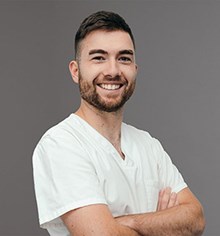Examination for laser vision correction
The examination for laser vision correction is a very detailed examination of all parts of the eye. To implement this procedure, the eye needs to be healthy, i.e. any irregularities, diseases or conditions must be either cured or well controlled before laser vision correction is performed.
The examination for the laser vision correction begins with
assessment of corneal topography (imaging of the anterior transparent part of the eye) in order to gain insight into corneal curvature and thickness.
After corneal imaging, assessment of whole eye high order aberrations is performed. Those tests are performed to detect any irregularities, other than diopter, which could potentially decrease the performances of the eye as an optical apparatus.
After those tests, patient's visual acuity is checked.
After above mentioned examinations, the pupils are dilated for the purpose of additional objective assessment of the diopter (the dilation of the pupil excludes muscle action, or the so-called accommodation that may show a false high or low diopter in some patients).
Also as part of the examination intraocular pressure is measured, tear film evaluated, and detailed examination of posterior part of the eye (retina) is performed. Fundoscopic examination includes an examination of the optic nerve, the macula (center of sight), and the periphery of the retina, which is often thinned in people with high diopters.
In case of finding any irregularities, we perform more tests depending on the finding.
Duration of the examination is usually between 90 and 120 minutes. Patients who wear contact lenses must discontinue their usage before the examination (contact lenses can change corneal surface and influence measurements). For soft contact lenses this should be done three days before the examination and for (semi) rigid contact lenses eight full days before the examination. Due to the dilation of the pupils, the vision may be slightly blurred for a short period after the examination.
Am I a candidate for laser vision correction?
95% of persons older than 18 years of age with a diopter being stable for a year (changes in the diopter less than 0.50D) can undergo laser vision correction. The laser can correct the diopter from -10.0 to +6.0 and up to ± 6.0 cylinders of astigmatism.
Laser vision correction can correct myopia (shortsightedness), hyperopia (farsightedness) and astigmatism so that the patient will not have to be dependent on glasses or contact lenses.
Glasses can be a nuisance for people who have active lifestyles, especially during sports activities. They wear contact lenses as an alternative.
Although contact lenses provide good vision for many people, they do have limitations such as a dry eye, eye allergies and eye infections. If you wear them for a longer period, contact lenses cause damage to the eye due to a lack of oxygen and can lead to the infection of the cornea that can be very serious. With these limitations, the solution method is LASIK.
The candidates for LASIK should:
- be older than 18 years of age
- have a stable diopter for at least a year
- have a diopter in the range from -10.0 to +6.0 to ± 6.0 cylinders of astigmatism
- have a healthy cornea

